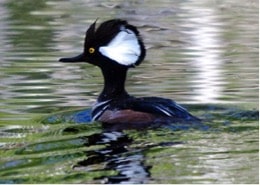
by Crystal Cockman
4/25/2018

Hooded mergansers (Lophodytes cucullatus) are small ducks with a fan-shaped crest on their head, which makes it look oversized. The head of the male duck is black with a large white patch. They have a white chest and chestnut colored flanks. Female and immature ducks are grey and brown with cinnamon colored heads. Eyes of the males are small and round, and are amber to yellow in color. Females have brown eyes.
The Hooded Merganser is the smallest of three North American mergansers and the only one restricted to this continent. Hooded mergansers breed from southeastern Alaska, central British Columbia and southwestern Alberta to southwestern Oregon, central Idaho and northwestern Montana; and from central Saskatchewan to Nova Scotia, south to Kansas, northern Louisiana and northern Georgia. Hooded Mergansers migrate short distances. They have usually left coastal wintering areas by April and return in mid-November.
Hooded mergansers are diving ducks, meaning they dive down to catch their prey, which includes crayfish, aquatic insects, and small fish. Mergansers are able to catch fish by direct underwater pursuit, remaining submerged for up to 2 minutes. In summer, they are found on small bodies of fresh water where they nest in holes in trees. Baby ducks leap to the forest floor when they are only one day old. In winter, they are found in larger bodies of freshwater, marshes, and protected saltwater bays.
Nearly all ducks are seasonally monogamous, forming pair bonds with new partners every year, and this is true for the hooded merganser. Male ducks display to female ducks during the winter, and once they attract a female, the two will remain together until they mate the following spring. They have a low voice except during mating. They emit grunting or croaking sounds, uttering hoarse but low-pitch grunts and chatters. Some refer to hooded mergansers as frog ducks because of the long guttural call that can be heard a half mile away. Incubation takes approximately 30 days, and the female will lay 9-11 eggs. The fledging duration is approximately 70 days, at which time the young remain with the female for protection.
The hooded merganser usually gathers in small groups of no more than 10 or 12. When they are startled, they will fly away. They are one of the fastest flying ducks. They fly fast by shallow wing beats, and can fly at speeds approaching 50 mph. The average lifespan of the hooded merganser is 11-12 years in the wild. The lifespan in captivity is around 13.4 years. The oldest recorded age of a Hooded Merganser is 14 years, 6 months.
Habitat destruction and loss of nesting cavities contributed to a decline in the population of hooded mergansers. However, more recently with the introduction of nesting boxes (many intended for wood ducks, but used also by mergansers), and wetland restoration efforts, the population appears to be on the increase. Hooded mergansers do not breed until age 2, and therefore have low productivity rates. They are also slow to colonize new breeding sites, which makes it even more important to conserve areas where they are already breeding.